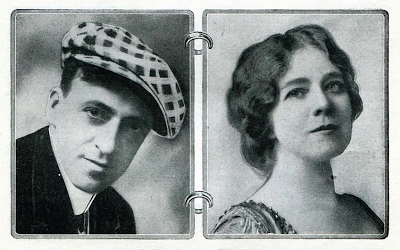Mae Hotely was respected as a comedienne, a dramatic actress, and a versatile character actress. She was once referred to as “The character actress who makes things happen in Lubin films,” and she headed the company’s comedy arm under her husband watchful eye. But as the 1910s came to an end, the studio systems began to take shape, and Lubin declared bankruptcy, she faded into the background, largely forgotten to modern audiences.
Much like Theda Bara, there’s a great deal of myth and misinformation surrounding Hotely’s birth and parentage. While she refused to divulge her age to the fan magazines, and claimed a variety of family histories, the oft-told story was that she was born in France and educated in a convent in Paris. Maye Shearor was actually born in Maryland in 1872 to William and Agnes Shearor (born in Scotland and Maryland, respectively). She would later claim different birthplaces for her father, her mother and herself on censuses, but the aforementioned dates and details were culled from the 1880 census (and probably much more reliable than Hotely herself).
She got involved in theatrical work via stock companies, and joined the Lubin company around the turn of the century. She moved from the stage branch to the film branch around 1907, and spoke highly of film to the fan magazines. “I think the motion picture is one of the most potent agencies for good in our modern life. It provides instruction and wholesome, innocent entertainment for the masses of the people,” she told Motion Picture Story in 1912, and Hotely herself was a very important part of that innocent entertainment, while under the direction of her husband Arthur Hotaling.
Arthur Hotaling and Mae Hotely
Hotely and Hotaling were married in August 1902, and she actually created her stage name as a play on his. He directed her at Lubin, and she remained the constant player in his company of actors. She was the star of the Lubin Comedy Company, and for good reason. She was well-versed in the ways of early screen comedy and was incredibly adept at makeup and transforming her appearance from one film to the next. If there was an old woman, a juvenile, a suffragette, or a crotchety maid in a Lubin picture, it was often her.
Although her comedic roles were what brought her fame, and brought audiences to theaters, she said she wanted to play dramatic roles, noting that the company wouldn’t let her. She did manage to get in a handful of dramatic roles a year, and won praise for them, as well.
Because Lubin was based in Philadelphia, the studio was essentially at a standstill for months at a time because of the harsh winter. Then Hotaling discovered that moving his company to a studio in Jacksonville, Florida would guarantee production when Philadelphia would not. The Jacksonville studio provided the group with a different environment and setting to work with and, for Hotely, a chance to explore her daredevil side. She took to outdoor sports quickly. Horseback riding, automobiling, motor boating, swimming, golfing...she was no dainty flower, and could keep up with the rest of the guys. Even Leola got the chance to appear in a film or two herself.
Lubin players, with Mae Hotely (top row, middle) & Arthur & Leola Hotaling (bottom row, middle)
After four years in Jacksonville, Hotaling made big changes. He uprooted the company, cut ties with a number of players, and moved the remaining few to set up shop in LA in 1915. He positioned the company with the intention of billing Mae as the star, but she needed someone to play off of. Fred Karno graduate Billie Reeves was engaged to play opposite her, as was a young Oliver Hardy, but by 1916, her popularity was waning. The woman who used to dominate fan contests left and right was suddenly singled out by the folks at Photoplay who were asking readers, “How long since you have seen Hotely in new roles which impressed you?” Shortly after that, Lubin declared bankruptcy and she disappeared from the film landscape until a role in “Girls Who Dare” brought her back briefly in 1929. Hotaling, on the other hand, continued to direct into the ‘20s.
Mae Hotely drumming up votes in a popular photoplayer contest
By 1930, she was retired. Hotaling died eight years later, and though some sources claim otherwise, they were still married at the time of his death. The 1940 census lists Hotely as the widowed head of house, living with her daughter and son in law. She died April 6, 1954 in San Diego.
I can't help but wonder what might have happened had Hotely's career been resurrected with that appearance in 1929. Like Marie Dressler, I can see her taking on character roles, playing just-past-their prime matriarchs and ornery mothers-in-law. Unfortunately, the opportunity never came around, and the ability to watch Hotely's Lubin films is extremely limited, making it difficult for us to appreciate just how popular she was at her height.
Did you enjoy this post? Please leave a comment or share it with fellow silent film lovers!








No comments:
Post a Comment